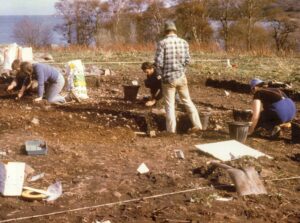
I recently attended a fabulous archaeological meeting in Argyll. Some 70 participants, a mix of professional and community archaeologists, spent two days discussing the finer points of the archaeology of the area, from the earliest times to recent remains. Set amidst the wonderful landscape of the Kilmartin Glen, it was a privilege to be able to devote the time to unpicking the finer points of the archaeology and history of this remarkable area.
I learnt a lot, not least because the format of the meeting meant that everyone participated in everything, even outside our usual period specialisations. This meant that each period benefitted from some alternative points of view. It also meant that I was forced to consider the archaeology of periods about which I know little. Not surprisingly, there was more overlap than I originally expected.
Surprises and differences were also evident, however. During a consideration of historical evidence, I was startled to find myself embroiled in a passionate discussion as to whether we should embrace interdisciplinary projects. To me this is a no brainer. How can we ever understand our ancestors properly, if we don’t understand the world in which they lived? We need to research vegetation, relative sea-level change, and geology, among other things, if we want to gain a full picture of that world. Indeed, the rise of specialist analysis is adding almost monthly to the suite of aspects that we can learn about the people of the past. Who would have thought that the study of isotopes might reveal so much, or that detailed DNA material might be available in sediments?
It was shocking to realise that there are people for whom the study of the material culture of the past is sufficient in isolation. I wonder why this is? Does the lack of material culture in the Mesolithic mean that we have been forced to look more broadly in order to justify ourselves? Perhaps, it is because the lives of those who inhabited Mesolithic Scotland were intertwined so closely with the world around them that we take that into account in our studies. And yet, the geographical nature of Scotland today is fundamental to an understanding of our own lives.
I appreciate now why so many grant forms spell out that they like to receive applications that comprise interdisciplinary studies. It is not obvious to everyone. These differences in how we do archaeology are fascinating. We think that we are all part of one broad profession, and yet at meetings like this we become aware of the different paths that we each follow. Sadly, one side effect of the increasing availability of specialist analyses is that it is becoming less common for one meeting to embrace a wide range of those disciplines that go together to make up our understanding of the past.
Talking of which, I took part in an archaeology podcast earlier in the autumn with Kim Biddulph of the Archaeology Podcast Network and Spencer Carter, another Mesolithic aficionado. We were discussing the use of fiction to interpret the Mesolithic and you can eavesdrop on our conversation here.
You must be logged in to post a comment.